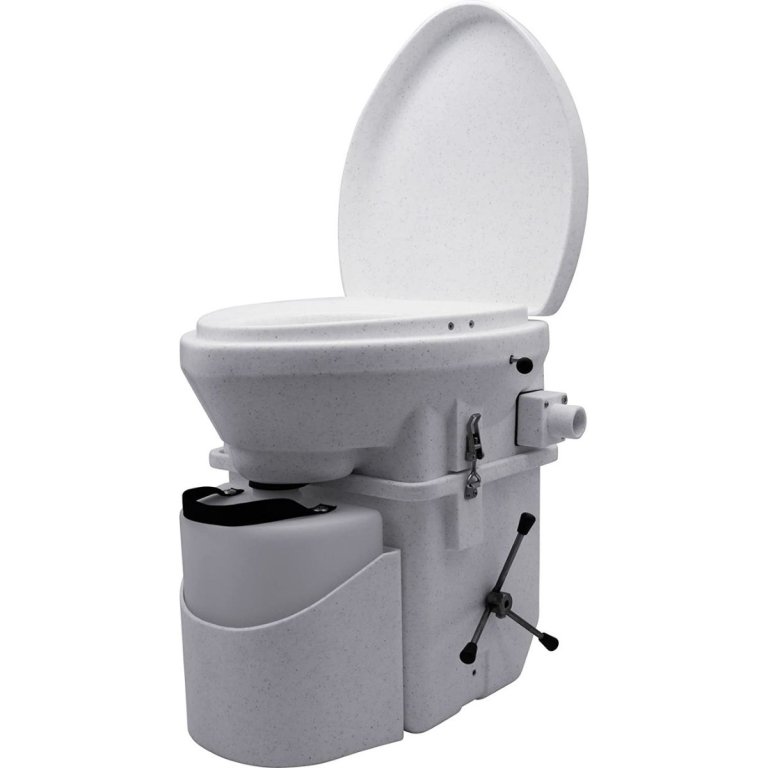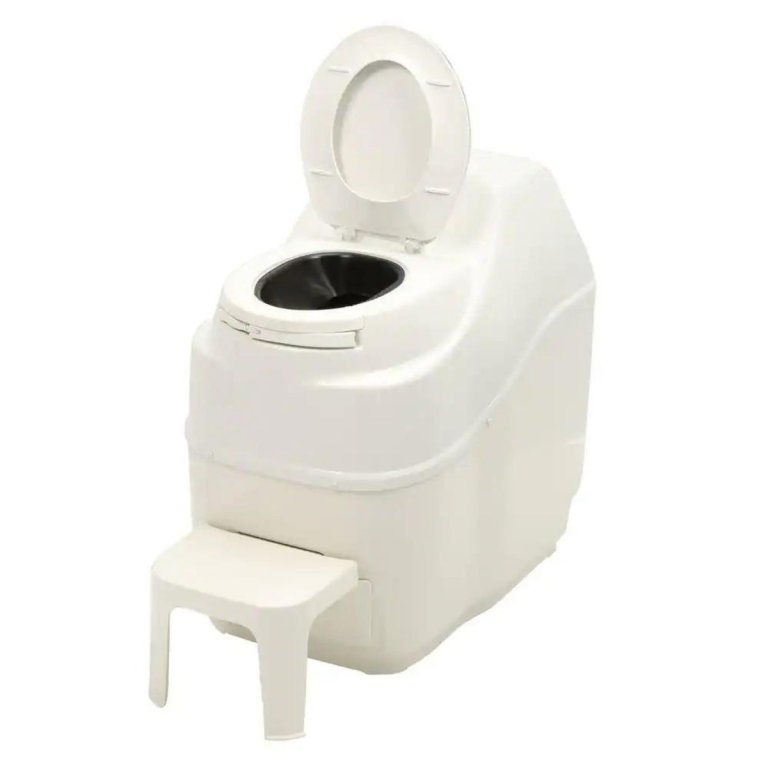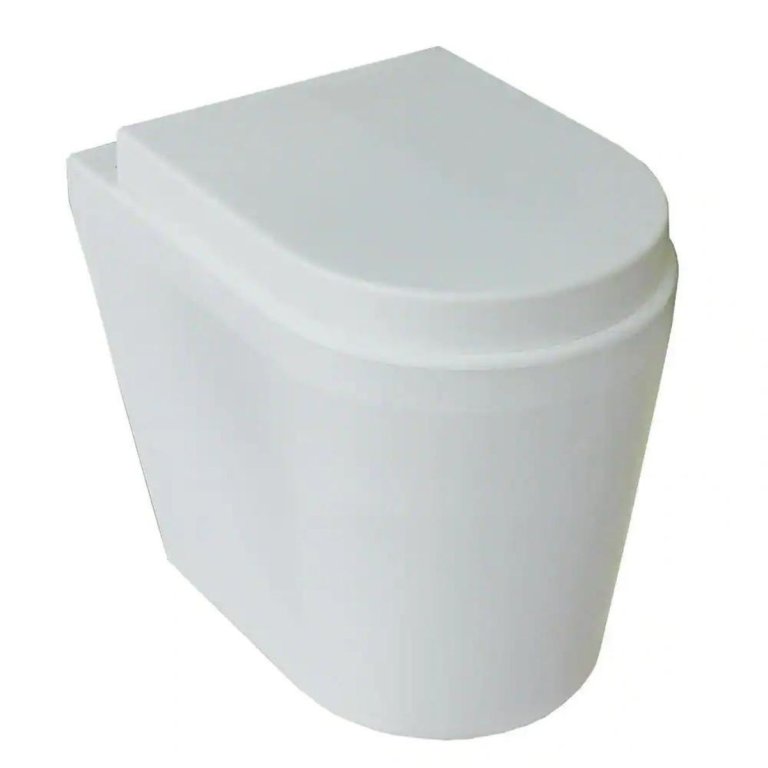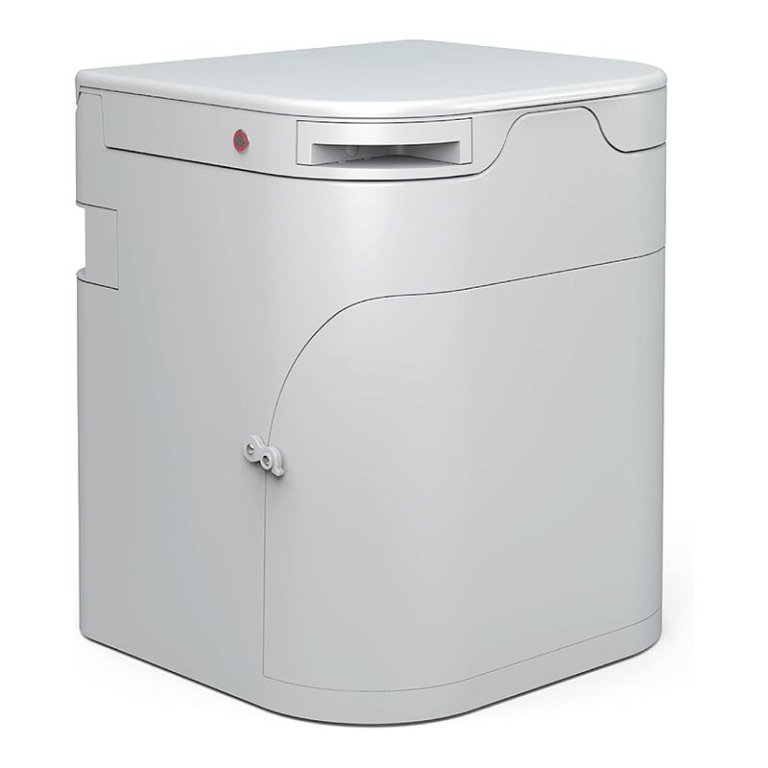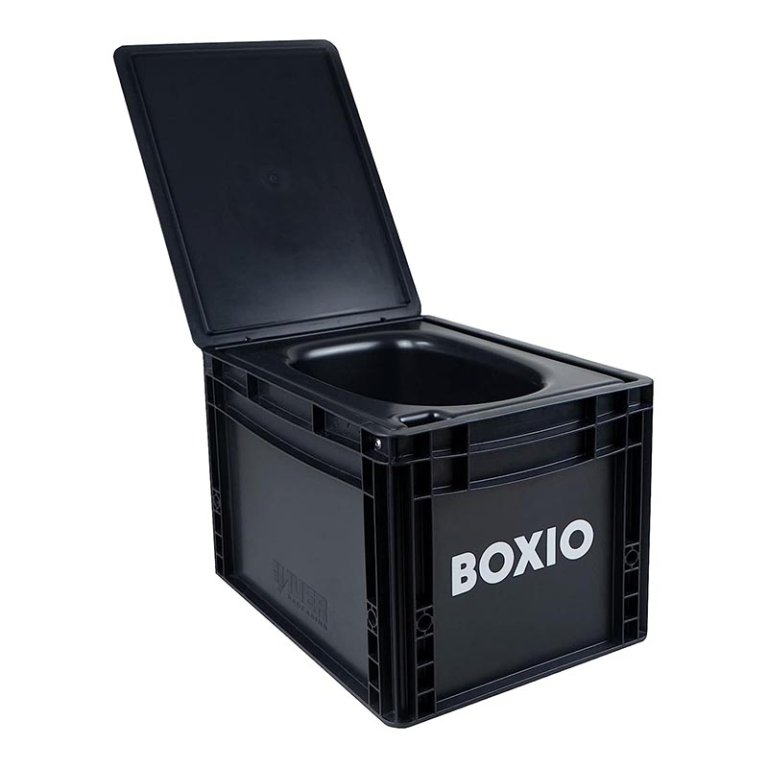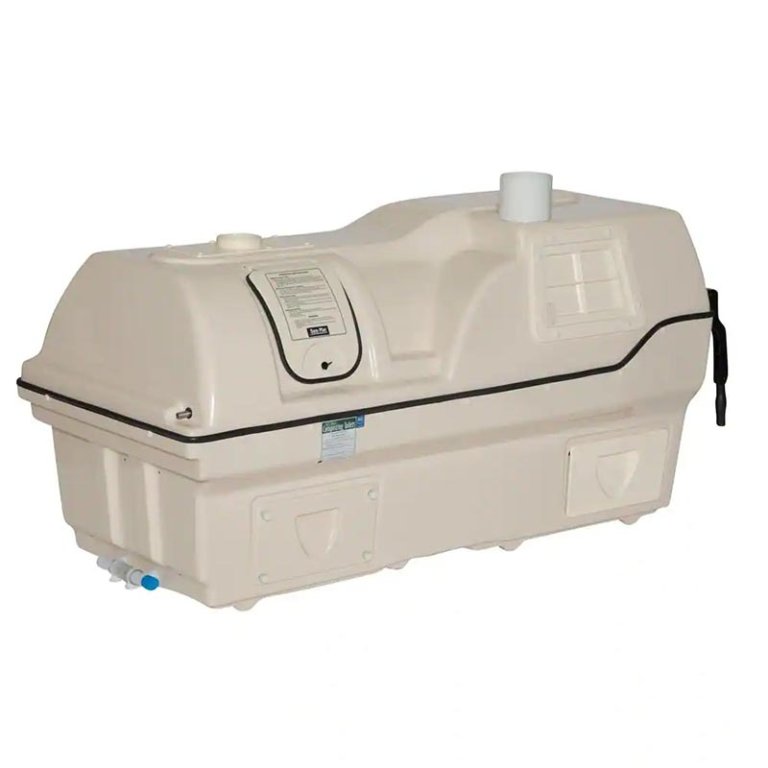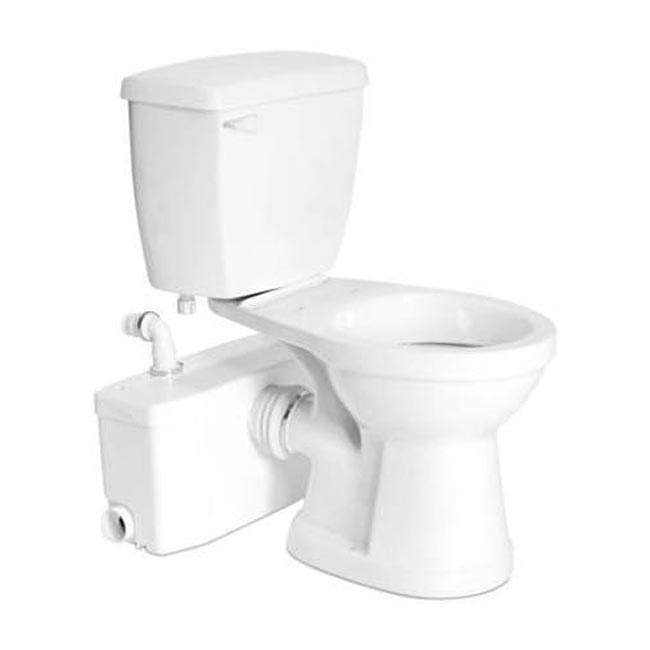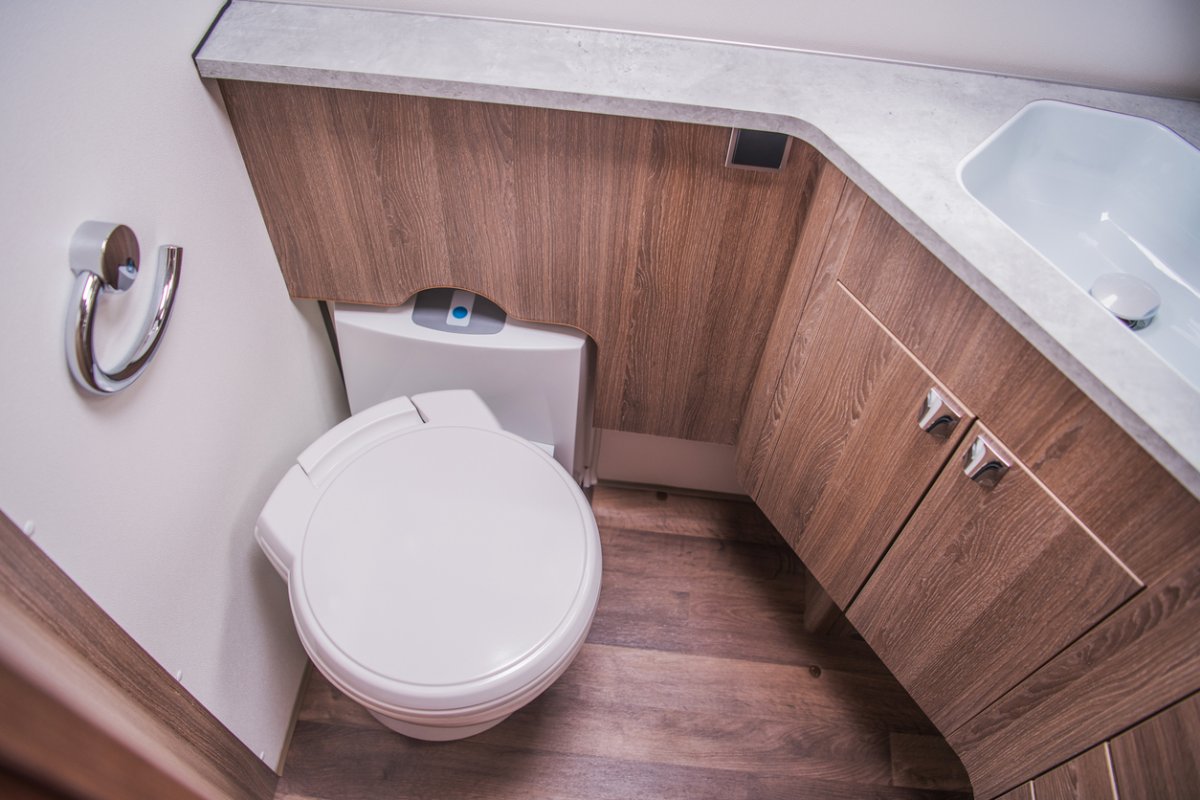
We may earn revenue from the products available on this page and participate in affiliate programs. Learn More ›
For folks with mobile homes or tiny houses that lack the plumbing to support a traditional flushing commode, a composting toilet could be the solution. This unusual kind of toilet uses aerobic bacteria to break down human waste and stows it in a neat, easy-to-remove package.
This type of toilet separates liquids from solids, breaking down the solid waste and toilet paper with organic materials and bacteria to become manure. While these folks can dispose of the waste in a trash bag if local regulations allow, it can also be used in a garden—if they should choose. This guide offers shopping tips and evaluates the best composting toilet picks below. Our top pick is the Nature’s Head Self-Contained Composting Toilet thanks to its lightweight and portable build as well as its impressive ventilation.
- BEST OVERALL: Nature’s Head Self-Contained Composting Toilet
- RUNNER-UP: Sun-Mar Excel Electric Waterless Composting Toilet
- BEST BANG FOR THE BUCK: Sun-Mar GTG Electric Composting Toilet
- BEST FOR ODOR CONTROL: OGO Compost Toilet
- BEST PORTABLE: Boxio Portable Composting Camping Toilet
- BEST COMPACT: Separett Villa 9215 AC/DC Composting Toilet
- BEST HIGH-CAPACITY: Sun-Mar Centrex 3000 High-Capacity Composting Toilet
- ALSO CONSIDER: Saniflo SaniPLUS Macerating Upflush Toilet Kit
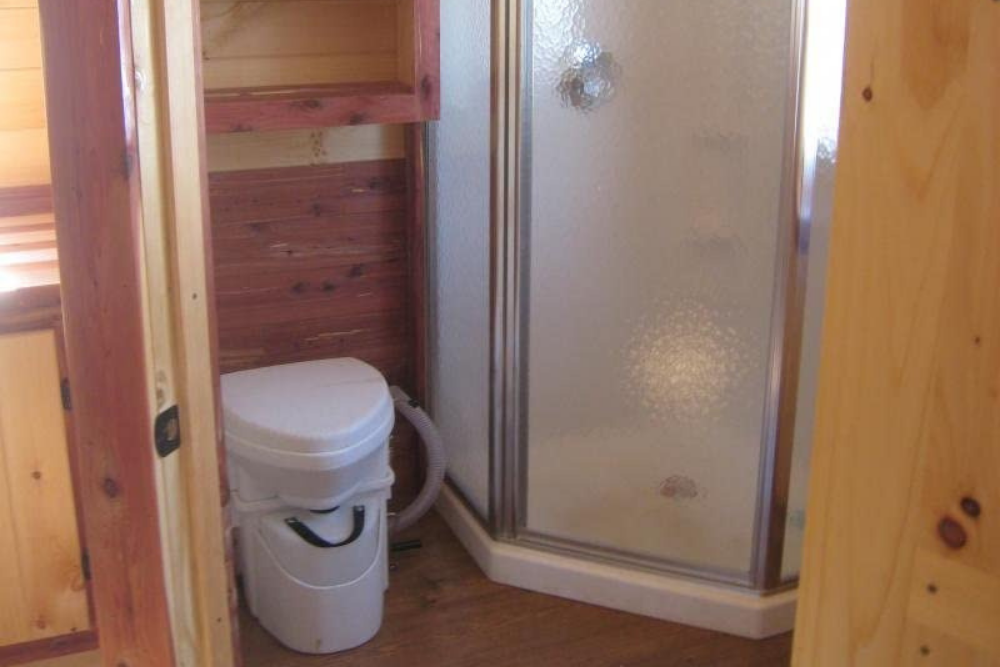
| Weight | Capacity | Power | |
| Nature’s Head Self-Contained Composting Toilet | 28 pounds | 2 adults | 12 volts |
| Sun-Mar Excel Electric Waterless Composting Toilet | 60 pounds | 3 adults | 12 volts |
| Sun-Mar GTG Electric Composting Toilet | 25 pounds | N/A | 12 volts |
| OGO Compost Toilet | 34 pounds | 25 to 30 trips | 12 volts |
| Boxio Portable Composting Camping Toilet | 8.3 pounds | Enough for 10 trips | None |
| Separett Villa 9215 AC/DC Composting Toilet | 30 pounds | Family of 4 | 12 or 110 volts |
| Sun-Mar Centrex 3000 High-Capacity Composting Toilet | 110 pounds | 5 to 7 adults | Nonelectric |
| Saniflo SaniPLUS Macerating Upflush Toilet Kit | NA | Unlimited | 110 volts |
Our Top Picks
The following are some of the best composting toilets (or alternatives to composting toilets) on the market. Be sure to review each and then check out the top shopping considerations listed below.
Best Overall
Nature’s Head Self-Contained Composting Toilet
See ItWhat We Like
- Enough to handle 2 adults’ worth of regular bathroom trips
- Lightweight and portable
- Ventilation fan eliminates odors
- Spider-handle design
What We Don’t Like
- Converting to 110 volts requires a conversion kit
Product Specs
- Weight: 28 pounds
- Capacity: 2 adults
- Power: 12 volts
When it comes to a durable, easy-to-use composting toilet, it’s tough to beat this Nature’s Head model. It diverts urine into an easily removed tank and features a side-mounted “spider” handle for churning the solid waste inside the tank. The waste tank is large enough for two adults to use full-time, which will require emptying every 4 to 6 weeks.
The Nature’s Head composting toilet uses an electric fan to draw fresh air in and push odors out, helping to keep smells at bay. While the fan uses 12-volt power, it can convert to 110 volts with a kit purchased directly from Nature’s Head.
Get the Nature’s Head composting toilet at Amazon.
Runner-Up
Sun-Mar Excel Electric Waterless Composting Toilet
See ItWhat We Like
- Large capacity can handle up to 3 adults
- Includes pull-down step to save space
- Vent and fan remove odors
What We Don’t Like
- Heavier than most composting toilets
Product Specs
- Weight: 60 pounds
- Capacity: 3 adults
- Power: 12 volts
The Sun-Mar Excel composting toilet is worth looking into when shopping for an eco-friendly model. This composting toilet uses an electric fan to dry liquids, but it also draws air into the tank and pushes waste gasses out of the vent to purge odors. The self-contained tank is large enough for three adults.
Even with the Sun-Mar Excel’s large capacity, it weighs just 60 pounds, and installation should be fairly easy. It may, however, require an additional electric kit to wire it for 12-volt power in a boat or camper.
Get the Sun-Mar Excel composting toilet at The Home Depot.
Best Bang for the Buck
Sun-Mar GTG Electric Composting Toilet
See ItWhat We Like
- Affordable option compared to most other composting toilets
- The venting fan manages odors
- Lightweight and portable
- Compact design
What We Don’t Like
- The seat might be slightly on the small side
Product Specs
- Weight: 25 pounds
- Capacity: N/A
- Power: 12-volt power
The Sun-Mar GTG composting toilet is worth a look when searching for a compact, portable design that also composts. Unlike other travel models that still need emptying into a sewer, the self-contained GTG produces the same type of compost as other much larger toilets. And its waterless design allows you to save on your water bill.
The GTG is a waterless toilet with a 12-volt-powered fan. It separates solid and liquid waste, dividing them into two easy-to-remove containers. It weighs just 25 pounds—a plus for portability—and measures 19.8 inches high by 15.75 inches wide 24 inches deep, so it will fit in most bathrooms of tiny homes, RVs, and campers without issue.
Get the Sun-Mar GTG composting toilet at Lehman’s or The Home Depot.
Best for Odor Control
OGO Compost Toilet
See ItWhat We Like
- An electric fan pulls fumes and moisture away
- Stainless steel agitator
- Large-capacity liquid bottle and bin
What We Don’t Like
- The compact design might be too small for some folks
Product Specs
- Weight: 34 pounds
- Capacity: 25 to 30 trips
- Power: 12-volt power
Folks who love the idea of a composting toilet but not necessarily the odors they can emit should consider OGO’s compost toilet. This sleek machine features a small fan that pulls fumes and excess moisture away from the waste, pushing it outside through a ventilation system. This prevents odors from escaping and permeating the living space. The fan runs on 12-volt power, so it’s suitable for RVs and most tiny homes, though a converter may be necessary for standard voltage.
This unit separates solids from liquids. The liquids end up in the 2.4-gallon bottle in the front of the toilet while the waste heads to the solid bin. This allows for 25 to 30 uses before requiring emptying. The stainless steel power agitator ensures that bacteria and enzymes can access all of the waste for better composting as well. It may be slightly small for some, measuring just under 18.5 inches tall by 16 inches wide by 15 inches deep.
Get the OGO composting toilet at Amazon, Camping World, or OGO Toilet.
Best Portable
Boxio Portable Composting Camping Toilet
See ItWhat We Like
- Lightweight design
- Separates liquids and solids to prevent odors
- Can handle 10 toilet trips
What We Don’t Like
- Might not be the most comfortable
Product Specs
- Weight: 8.3 pounds
- Capacity: Enough for 10 trips
- Power: None
What it doesn’t have in fancy fans, agitators, and ventilation the Boxio toilet makes up for in portability. Weighing just 8.3 pounds, this plastic milk-crate-size composter can go just about anywhere you need to, well, go. It separates liquid from solids, and this helps prevent odor even without a power source or fan.
The Boxio’s main solid compartment has a capacity of 1.3 gallons and a separate bottle for liquid. This allows for up to 10 toilet trips before requiring emptying. For folks who don’t want to hold onto that nutrient-rich waste, Boxio’s Bio Bags are biodegradable and therefore disposable, making cleanup easy, mess-free, and environmentally friendly. This recycled-plastic throne measures 11 inches high by 11.81 inches wide by 14.75 inches deep. Given its size, however, it might not be the most comfortable composting toilet to sit on.
Get the Boxio composting toilet at Amazon or Boxio.
Best Compact
Separett Villa 9215 AC/DC Composting Toilet
See ItWhat We Like
- Compact and lightweight
- Multiple power options
- Ample tank capacity
- A fan ventilates odors
What We Don’t Like
- Multiple adapters to mate the vent with a 3-inch schedule 40 pipe
Product Specs
- Weight: 30 pounds
- Capacity: Family of 4
- Power: 12 or 110 volts
For an all-around compact composting toilet, check out the Separett Villa 9215. This waterless self-contained composting toilet has an electric fan to exchange gases, operating on both 110 volts in a house or on a 12-volt system in a boat or motor home. It’s lightweight at 30 pounds and on the small side, so it’s quite portable.
The kit provides the toilet, adapters for both 110-volt and 12-volt power, and all the parts for direct venting and for tying the liquid drain into a gray water system. The tank is large enough for around 3 weeks of use by an average-size family. If there’s a downside, it’s that the venting system was originally designed for European plumbing. Although it’s been revamped for the U.S. market, there are several adapters to use to mate it with 3-inch schedule 40 pipe.
Get the Separett composting toilet at Amazon.
Best High-Capacity
Sun-Mar Centrex 3000 High-Capacity Composting Toilet
See ItWhat We Like
- High capacity can handle up to 7 adults
- No electricity required
- Biodrum breaks down waste to turn it into fertilizer
What We Don’t Like
- It’s likely too large to use as a composting solution in an RV
Product Specs
- Weight: 110 pounds
- Capacity: 5 to 7 adults
- Power: Nonelectric
A composting toilet that sees regular use must be able to handle a lot of waste, and this high-capacity compost toilet system from Sun-Mar does. This model, which works with a 1-pint flush toilet or waterless toilet (sold separately), is capable of handling five adults or a family of seven for daily residential use or up to eight adults for seasonal use.
Once the waste is flushed from the toilet, it travels through a drain pipe to the Centrex 3000, which uses a biodrum to turn the human waste into fertilizer that can be recycled into the soil. Since the Centrex 3000 requires no electricity, it’s ideal for use as an off-grid living composting toilet or in tiny houses with no consistent electrical connection. Just keep in mind that at 30.25 inches high by 71 inches wide by 27.5 inches deep and 110 pounds, this composting toilet system does take up a fair amount of space.
Get the Sun-Mar Centrex composting toilet at The Home Depot.
Also Consider
Saniflo SaniPLUS Macerating Upflush Toilet Kit
See ItWhat We Like
- Installs up to 15 feet below the sewer lines
- Macerating blades and a 10-psi pump
- Can also handle wastewater from 1 sink and 1 shower
What We Don’t Like
- It does not hold on to waste to allow it to break down into compost
Product Specs
- Weight: NA
- Capacity: Unlimited
- Power: 110 volts
Many folks who plan to install a toilet below their sewer line think that composters are the only option, but that’s not the case. With a macerating upflush toilet kit like this model from Saniflo, DIYers and pros can install a toilet up to 15 feet below their sewer line. The whole kit takes up roughly the same amount of space as a standard toilet, and it requires a 110-volt power source and water supply.
This kit features a relatively standard-looking toilet and a macerating tank and pump. The stainless steel macerating blades break the waste down into a slurry while the 10-pounds-per-square-inch (psi) pump pushes that slurry out of the tank and into the sewer system. This tank can also handle the wastewater from a sink and shower, allowing for a complete bathroom installation below the sewer lines. However, folks looking for a traditional composting toilet will have to look elsewhere as this kit is designed to get rid of the waste, not allow it to break down into nutrient-rich soil.
Get the Saniflo composting toilet at Amazon.
Jump to Our Top Picks
How We Chose the Best Composting Toilets
We considered a variety of factors when making our selections of top composting toilets. Since capacity is crucial, we only chose composting toilets that could capably handle multiple adults or entire families. Odor control is absolutely vital for a composting toilet to be effective, so we selected models with well-designed ventilation systems that prevent odors from overtaking the area around the toilet.
And, since a composting toilet for RV, tiny home, or boat use should be able to fit in a small space, we chose compact models while still keeping in mind that the toilet’s seat should be large enough to accommodate an adult comfortably. While cost was not a major factor, we did favor composting toilets that offer the best bang for the buck.
What to Consider When Choosing a Composting Toilet
Keep the following considerations in mind to make the best choice of composting toilet for any given application.
Types of Composting Toilets
Before purchasing a composting toilet, be sure that it will work in a given location. There are two types—self-contained and split/central systems—and while they both break down waste, they work a bit differently and have different requirements.
Self-Contained System
A self-contained compost toilet system consists of a small toilet with a detachable tank and a liquid drain for removing waste. Some self-contained systems are portable, which works for camping trips or boat rides and can be set up in a space where plumbing won’t reach, like a workshop or garage.
The entire composting process occurs within the toilet, hence the name. When full, remove the tank and empty the manure. These systems sometimes have freshwater tanks or supply lines as well to flush waste into the chamber below.
Split System or Central System
Composting toilets that work with split or central systems are similar to a traditional toilet. They connect to a system of pipes that take the waste to a central biodrum, hopper, or tank, which is where composting takes place. The hopper churns the waste, allowing it to break down while also venting the odorless gasses. When the tank fills, empty it just like a self-contained toilet.
A split compost toilet system is much more expensive than self-contained composters, as they require a hopper, usually installed below the toilet. The hoppers are a benefit because they significantly increase the amount of compost they can hold. They can be an attractive solution for permanent off-grid or eco-conscious homes, but the setup makes these composting toilets a poor choice for portability.
Available Space
Composting toilets take up a bit more floor space than a traditional toilet, and they don’t have an additional holding tank to contend with. For a tiny home or boat, look for a compact composting toilet with a smaller waste tank.
If space for a split system is available, it might be worth the investment to get the increased holding capacity. Areas like garages and cabins sometimes have the flexibility for adding a hopper. In warmer climates, installing the tank outside is an option.
Portable vs. Composting
A portable toilet and a composting one may seem similar, but there are some very significant differences. Composting toilets use bacteria to break down human waste. They separate solid and liquid waste, allowing the bacteria to feed upon the organic compounds in each. After the composting process, the humanure can fortify a lawn or garden. The byproduct of the composting process fertilizes the soil and brings nutrients to plants.
A portable toilet does nothing of the sort. With portable toilets, everything goes into one waste tank where liquids are not separated from solids. Even after pouring enzymes and deodorizers down into the tank to break solids down and offset odor, the end product still needs to find its way into a sewer or septic system. So while a portable toilet can be handy for camping and boating trips, it may not be the best choice for permanent residences like mobile homes and tiny abodes.
Tank Capacity
When searching for the best composting toilet, the number of people who will be using it should determine how big of a tank is required. Manufacturers often break this down by family size and appropriate use.
For instance, a split system with a high-capacity tank might handle waste from three adults or a family of five, while a self-contained composting toilet with a 5-gallon tank would be more than enough for one adult. The idea here is that by sizing the tank correctly, waste will have enough time to break down into manure before the tank fills.
Utility Usage
Some composting toilets use electricity to power a fan that draws air into the tank and across the waste. The air is rich in oxygen to feed the aerobic bacteria breaking down the waste. This also exchanges the carbon dioxide created by the bacteria, venting it into the air. Many work with a home’s 110-volt system, while some work with both 110-volt AC and 12-volt DC from a car or RV battery.
A composting toilet may also need a water line. While this seems counterintuitive, the composting toilets that use water consume very little with each flush—far less than a standard residential toilet. Waterless and nonelectric models are available too, so consider the utility setup and household budget when choosing a toilet that will work best.
Odor Removal
The gases created by a composting toilet’s bacteria need to be vented. Otherwise, odors could build up, or the bacteria’s performance could suffer from a lack of fresh oxygen. The fan some models use to draw air into the tank also forces the gases out through the vent, banishing unpleasant smells. Adding organic materials like sawdust on top of the waste after each use can block the odor while still allowing the bacteria to break down the solids.
FAQs
Still not feeling flush with knowledge about these toilets? Here are the answers to some important frequently asked questions. If you need more info, contact your toilet’s manufacturer.
Composting toilets hold waste in a tank and allow aerobic bacteria to break it down to a material similar to rich, moist soil.
Installing a self-contained nonelectric waterless unit is straightforward. The only concern is venting it outside. The directions that come with the toilet will have suggestions for vent-pipe sizes and heights.
Moderate amounts of toilet paper should be fine. Single-ply is probably best, but most composting toilets won’t have an issue since toilet paper is biodegradable.
Yes. The manure you end up with after the composting process is feces—just broken-down feces.
This depends on how often you’re supplying the toilet with fresh waste. The bacteria in your composting toilet will begin breaking down waste immediately, and it should take a few weeks to fill with humanure.
If you don’t want to use your compost for your lawn and garden, check with your local code enforcement about disposal. Some jurisdictions allow you to bag it up and throw it in your garbage.



